- Home
- Geraldine Brooks
People of the Book Page 3
People of the Book Read online
Page 3
But no one knew why this haggadah was illustrated with numerous miniature paintings, at a time when most Jews considered figurative art a violation of the commandments. It was unlikely that a Jew would have been in a position to learn the skilled painting techniques evinced here. The style was not unlike the work of Christian illuminators. And yet, most of the miniatures illustrated biblical scenes as interpreted in the Midrash, or Jewish biblical exegesis.
I turned the parchment and suddenly found myself gazing at the illustration that had provoked more scholarly speculation than all the others. It was a domestic scene. A family of Jews—Spanish, by their dress—sits at a Passover meal. We see the ritual foods, the matzoh to commemorate the unleavened bread that the Hebrews baked in haste on the night before they fled Egypt, a shank bone to remember the lamb’s blood on the doorposts that had caused the angel of death to “pass over” Jewish homes. The father, reclining as per custom, to show that he is a free man and not a slave, sips wine from a golden goblet as his small son, beside him, raises a cup. The mother sits serenely in the fine gown and jeweled headdress of the day. Probably the scene is a portrait of the family who commissioned this particular haggadah. But there is another woman at the table, ebony-skinned and saffron-robed, holding a piece of matzoh. Too finely dressed to be a servant, and fully participating in the Jewish rite, the identity of that African woman in saffron has perplexed the book’s scholars for a century.
Slowly, deliberately, I examined and made notes on the condition of each page. Each time I turned a parchment, I checked and adjusted the position of the supporting forms. Never stress the book—the conservator’s chief commandment. But the people who had owned this book had known unbearable stress: pogrom, Inquisition, exile, genocide, war.
As I reached the end of the Hebrew text, I came to a line of script in another language, another hand. Revisto per mi. Gio. Domenico Vistorini, 1609. The Latin, written in the Venetian style, translated as “Surveyed by me.” Were it not for those three words, placed there by an official censor of the pope’s Inquisition, this book might have been destroyed that year in Venice, and would never have crossed the Adriatic to the Balkans.
“Why did you save it, Giovanni?”
I looked up, frowning. It was Dr. Karaman, the librarian. He gave a tiny, apologetic shrug. Probably he thought I was irritated at the interruption, but actually I was surprised that he had voiced the very question in my mind. No one knew the answer; any more than they knew how or why—or even when—the book had come to this city. A bill of sale from 1894 stated that someone named Kohen had sold it to the library. But no one had thought to question the seller. And since World War II, when two-thirds of the Jews in Sarajevo were slaughtered and the city’s Jewish quarter ransacked, there had been no Kohens left in the city to ask. A Muslim librarian had saved the book from the Nazis then, too, but the details of how he’d done it were sparse and conflicting.
When I had completed the notes on my initial examination, I set up an eight-by-ten camera and worked through again from the beginning, photographing every page so as to make an accurate record of the book’s condition before any conservation work was attempted. When I was done with the conservation work and before I re-bound the pages, I would photograph each page again. I would send the negatives to Amitai in Jerusalem. He would direct the making of a set of high-grade prints for the world’s museums and the printing of a facsimile edition that ordinary people everywhere would be able to enjoy. Normally, a specialist would do those photos, but the UN didn’t want to jump through the hoops of finding another expert that passed muster with all the city’s constituencies, so I’d agreed to do it.
I flexed my shoulders and reached for my scalpel. Then I sat, my chin resting on one hand, the other poised over the binding. Always a moment of self-doubt, at the instant before you begin. The light glinted on the bright steel, and made me think of my mother. If she hesitated like this, the patient would bleed out on the table. But my mother, the first woman to chair a department of neurosurgery in the history of Australia, was a stranger to self-doubt. She hadn’t doubted her right to flout every convention of her era, bearing a child without troubling to take a husband, or even naming a father. To this day, I have no idea who he was. Someone she loved? Someone she used? The latter, more likely. She thought she was going to raise me in her own image. What a joke. She’s fair and perpetually tennis-tanned; I’m dark and pale as a Goth. She has champagne tastes. I prefer beer straight out of the tinnie.
I realized a long time ago that she would never respect me for choosing to be a repairer of books rather than bodies. For her, my double-honors degrees in chemistry and ancient Near Eastern languages might as well have been used Kleenex. A masters in chemistry and a PhD in fine art conservation didn’t cut it, either. “Kindergarten work,” she calls it, my papers and pigments and pastes. “You’d be through your internship by now,” she said when I got back from Japan. “At your age I was chief resident” was all I got when I came home from Harvard.
Sometimes, I feel like a figure in one of the Persian miniatures I conserve, a tiny person forever watched by immobile faces, staring down from high galleries or spying from behind lattice screens. But in my case, the faces are always just that one face, my mother’s, with her pursed mouth and disapproving glare.
And here I am, thirty years old, and still she can get between me and my work. That feeling, of her impatient, disapproving scrutiny, finally stirred me. I slipped the scalpel under the thread, and the codex eased apart into its precious folios. I lifted the first one. A tiny speck of something fluttered from the binding. Carefully, with a sable brush, I moved it onto a slide and passed it under the microscope. Eureka. It was a tiny fragment of insect wing, translucent, veined. We live in a world of arthropods, and maybe the wing came from a common insect and wouldn’t tell us anything. But maybe it was a rarity, with a limited geographic range. Or maybe it was from a species now extinct. Either would add knowledge to the history of the book. I placed it in a glassine envelope and labeled it with a note of its position.
A few years ago, a tiny sliver of quill paring I’d found in a binding had caused a complete uproar. The work was a very beautiful little set of suffrages, short prayers to individual saints, supposedly part of a lost Book of Hours. It was owned by an influential French collector who had charmed the Getty into considering paying an absolute fortune for it. The collector had provenance documents going way back, attributing it to the Bedford Master who had painted in Paris around 1425. But something about it didn’t sit just right with me.
Generally, a quill paring won’t tell you much. You don’t need an exotic feather to make a quill. Any good strong flight feather from any robust bird can be made into a serviceable pen. It always makes me laugh when I see actors in period movies scribbling away with flamboyant ostrich feathers. For one thing, there weren’t a whole lot of ostriches marching around in medieval Europe. And for another, scribes always trimmed the feather down to something that looked pretty much like a stick, so the fluffy bits didn’t get in their way while they were working. But I insisted on checking out the paring with an ornithologist, and what do you know? The paring came from a Muscovy duck feather. Muscovys are common everywhere these days, but in the 1400s they were still pretty much confined to Mexico and Brazil. They weren’t introduced to Europe until the early 1600s. Turned out the French “collector” had been faking manuscripts for years.
As I gently lifted off the haggadah’s second folio, I drew out the frayed thread holding it, and noticed that a fine white hair, about a centimeter long, had become trapped in the thread fiber. Checking under magnification, I could see that the hair had left a very slight indentation near the binding, on the page that depicted the Spanish family seder. Gently, with surgical tweezers, I disentangled it and placed it in its own envelope.
I needn’t have worried about the people in the room being a distraction. I didn’t even notice they were there. People came and went, and I didn’t rais
e my head. It was only when the light began to fade that I realized I’d worked right through the day without a break. I suddenly felt stiff from tension, and ravenously hungry. I stood, and Karaman was immediately there, his dreadful metal box ready. I laid the book with its separated folios carefully inside.
“We absolutely have to change this right away,” I said. “Metal is the worst thing for transmitting variations in heat and cold.” I placed a sheet of glass on top and weighed it with little velvet sandbags to keep the parchments flat. Ozren fiddled with his wax, stamps, and strings while I cleaned and organized my tools. “How do you find our treasure?” he said, inclining his head toward the book.
“Remarkable for its age,” I said. “There’s no apparent recent damage from inappropriate handling. I’m going to do some tests on a few microscopic samples to see what they’ll tell us. Otherwise, it’s just a matter of stabilization, and repair of the binding. As you know, it’s a late-nineteenth-century binding, and about as physically and mechanically tired as you’d expect.”
Karaman leaned down hard on the box, pressing the library’s stamp into the wax. Then he stood aside while a bank official did the same with the bank’s stamp. The elaborate weave of strings and wax seals meant that any unauthorized access to the contents of the box would be instantly apparent.
“I’d heard that you are Australian,” Karaman said. I suppressed a sigh. I was still transported by my day’s work and not in the mood for small talk. “It seems a strange occupation for a person from such a young country, looking after other people’s ancient treasures.” I didn’t say anything. Then he added: “I suppose you were hungry for some culture, growing up there?”
Because I had been rude before, I made an effort now. A slight effort. That young country–cultural desert stuff gets very old. Australia happens to have the longest continuous artistic tradition in the world—Aboriginal people were making sophisticated art on the walls of their dwellings thirty thousand years before the people in Lascaux chewed the end off their first paintbrush. But I decided to spare him the full lecture. “Well,” I said, “you should consider that immigration has made us the most ethnically diverse country in the world. Australians’ roots run very deep and wide. That gives us a stake in all the world’s cultural heritage. Even yours.” I didn’t add that when I was growing up, the Yugoslavs were famous as the only migrant group who’d managed to import their Old World grievances. Everyone else soon succumbed to a kind of sunstruck apathy, but Serbs and Croats were forever going at it, bombing each other’s soccer clubs, stoushing with each other even in end-of-the-earth outback shitholes like Coober Pedy.
He received the barb with good grace, smiling at me over the box. He had a very nice smile, I have to say. His mouth sort of turned down and up at the same time, like a Charles Schulz drawing.
The guards stood to escort Karaman and the book. I followed down the long, ornate corridors until they descended the marble staircase to the vaults. I was waiting for someone to unlock the main doors when Karaman turned back and called after me.
“Perhaps I could invite you to dinner? I know a place in the Old City. It just reopened last month. To be quite frank and sincere, I cannot guarantee the food, but at least it will be Bosnian.”
I was about to say no. It’s just a reflex with me. And then I thought, why not? Better than some bland, room-service mystery meat in my bleak little hotel room. I told myself that it was legitimate research. Ozren Karaman’s rescue had made him part of the history of the book, and I wanted to know more about that.
I waited for him at the top of the stairs, listening to the pneumatic swish of the vault and then the clang of the metal bars that enclosed it. The sound was final and reassuring. The book, at least, would be safe for the night.
III
WE STEPPED OUT into the dark city streets, and I shivered. Most of the snow had disappeared during the day, but now the temperature was dropping again, and heavy clouds hid the moon. There were no streetlights working. When I realized that Karaman proposed to walk to the Old City, the feeling of a stone in the gut returned.
“Are you sure that’s, you know, OK? Why don’t we have my UN escort drive us?”
He made a slight face, as if he smelled something unappetizing. “Those oversized tanks they drive will not fit in the narrow ways of the Baščaršija,” he said. “And there has been no sniping for over a week now.”
Great. Tremendous. I let him handle the argy-bargy with the UN Vikings, hoping he wouldn’t be able to convince them to let me go on without an escort. Unfortunately, he was a pretty persuasive fellow—stubborn, anyway—and finally we set off on foot. He had a long-legged stride, and I had to quicken my pace to keep up with him. As we walked, he delivered a kind of countertourism monologue—a guide-from-hell kind of a thing—describing the city’s various shattered structures. “That is the Presidency Building, neo-Renaissance style and the Serbs’ favorite target.” A few blocks farther: “That is the ruins of the Olympic Museum. That was once the post office. This is the cathedral. Neo-Gothic. They had midnight Mass there last Christmas, but they held it at noon because, of course, no one went out at night at that time unless they were suicidal. On its left you see the synagogue and the mosque. On the right the Orthodox church. All the places where none of us go to worship, situated within a very convenient hundred meters of one another.”
I tried to imagine how I would feel if Sydney were suddenly scarred like this, the landmarks of my childhood damaged or destroyed. Waking up one day and finding that the people in North Sydney had set up barricades on the Harbour Bridge and started shelling the Opera House.
“I suppose it’s still a bit of a luxury to walk in the city,” I said, “after four years of running from snipers.” He was walking a little bit ahead of me. He stopped suddenly.
“Yes,” he said. “Quite.” Somehow he poured a whole bucket of sarcasm into that terse reply.
The wide avenues of Austro-Hungarian Sarajevo had gradually given way to the narrow, cobbled footpaths of the Ottoman town, where you could stretch out your arms and almost touch buildings on opposite sides of the way. The buildings were small scale, as if built for halflings, and pressed together so tightly that they reminded me of tipsy friends, holding each other upright on the way home from the pub. Large parts of this area had been out of range of the Serb guns, so the damage here was much less evident than in the modern city. From a minaret, the khoja called the faithful to aksham, the evening prayer. It was a sound I associated with hot places—Cairo, Damascus—not a place where frost crunched underfoot and pockets of unmelted snow gathered in the crotch between the mosque’s dome and its stone palisade. I had to remind myself that Islam had once swept north as far as the gates of Vienna; that when the haggadah had been made, the Muslims’ vast empire was the bright light of the Dark Ages, the one place where science and poetry still flourished, where Jews, tortured and killed by Christians, could find a measure of peace.
The khoja of this small mosque was an old man, but his voice carried, unwavering and beautiful on the cold night air. Only a handful of other old men answered; shuffling across the cobbled courtyard, dutifully washing their hands and faces in the icy water of the fountain. I stopped for a moment to watch them. Karaman was ahead of me, but he turned back, and followed my gaze. “There they are,” he said. “The fierce Muslim terrorists of the Serb imagination.”
The restaurant he had chosen was warm and noisy and full of delicious aromas of grilling meat. A photograph by the door showed the proprietor, in military fatigues, brandishing an immense bazooka. I ordered a plate of cevapcici. He ordered a salad of shaved cabbage and a dish of yogurt.
“That’s a bit austere,” I said.
He smiled. “I’ve been a vegetarian since I was a child. That was useful, during the siege, since there wasn’t any meat. Of course, the only greens you could get most of the time were grass clippings. Grass soup, that became my specialty.” He ordered two beers. “Beer, you could get, even
during the siege. The brewery was one thing in the city that never closed down.”
“Aussies would approve of that,” I said.
“I was thinking about what you said earlier, about the people from this country who migrated to Australia. Actually, we had quite a few Australians visiting the museum library, just before the war.”
“Oh?” I said absently, sucking on my beer, which was, I have to say, a little soapy.
“Well dressed, speaking terrible Bosnian. Same peoples came from the United States as well. We averaged about five a day, looking up their family history. At the library we gave them a nickname, after that black man in the American TV show—Kinta Kunte.”
“Kunta Kinte,” I corrected.
“Yes, him: we called them the Kunta Kintes because they were searching for their roots. They wanted to look at the official gazettes, 1941 to ’45. Never looking for Partisans in their family tree. They didn’t want to be descendants of leftists. Always it was the nationalist fanatics—Chetniks, Ustashe, the killers of the Second World War. Imagine wanting to be related to such people. I wish I’d known then that they were the storm crows. But we didn’t want to believe that such madness could ever come here.”
“I’ve always kind of admired Sarajevans for being so surprised by the war,” I said. It had seemed the rational response to me. Who wouldn’t be in a state of denial when your next-door neighbor suddenly starts shooting at you, casually and without remorse, like you’re some kind of unwanted introduced species, the way the farmers at home eradicate rabbits.
“It’s true,” he said. “Years ago, we watched Lebanon fall apart and said, ‘That’s the Middle East, they’re primitive over there.’ Then we saw Dubrovnik in flames, and we said, ‘We’re different in Sarajevo.’ That’s what we all thought. How could you possibly have an ethnic war here, in this city, when every second person is the product of a mixed marriage? How to have a religious war in a city where no one ever goes to church? For me, the mosque, it’s like a museum, quaint thing to do with grandparents. Picturesque, you know. Once a year, maybe, we’d go and see the zikr, when the dervishes dance, and it was like theater—like, what do you call it? A pantomime. My best friend, Danilo, he’s a Jew, and he’s not even circumcised. There was no mohel here after the war; you had to go to the local barber. Anyway, our parents were all leftists, they thought such things were primitive….” He trailed off, downing his beer in a couple of swallows and ordering two more.

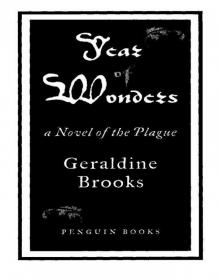 Year of Wonders
Year of Wonders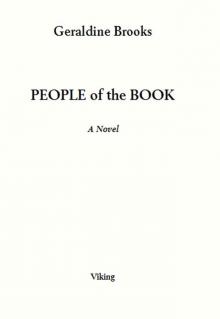 People of the Book
People of the Book The Secret Chord
The Secret Chord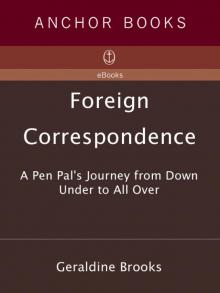 Foreign Correspondence
Foreign Correspondence Nine Parts of Desire (Korean Edition)
Nine Parts of Desire (Korean Edition)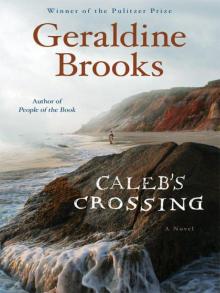 Caleb's Crossing
Caleb's Crossing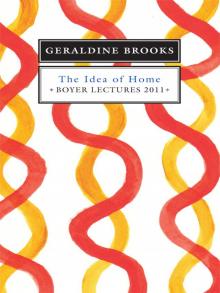 The Idea of Home
The Idea of Home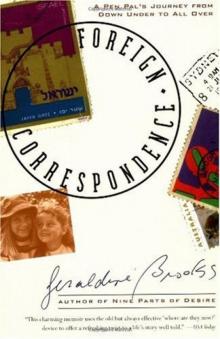 Foreign Correspondence: A Pen Pal's Journey
Foreign Correspondence: A Pen Pal's Journey March
March March: a novel
March: a novel The Best American Short Stories® 2011
The Best American Short Stories® 2011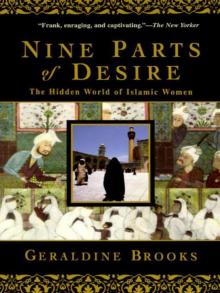 Nine Parts of Desire
Nine Parts of Desire